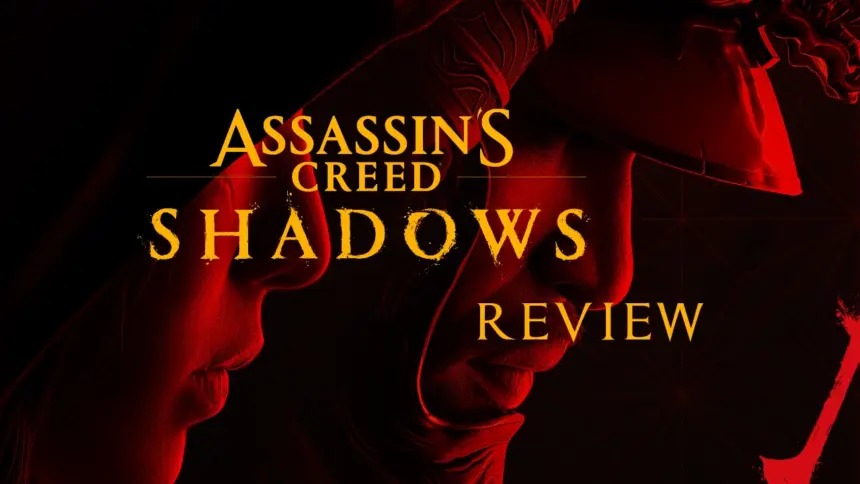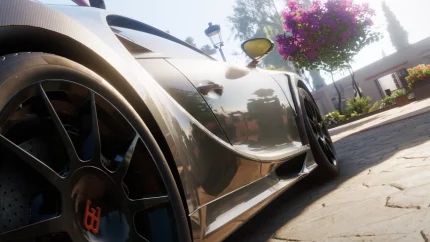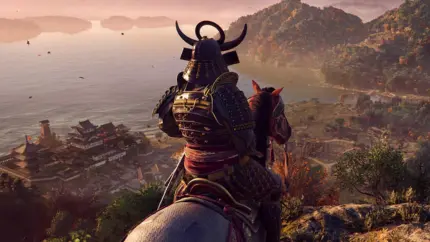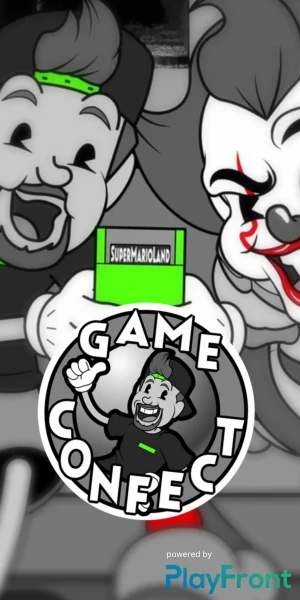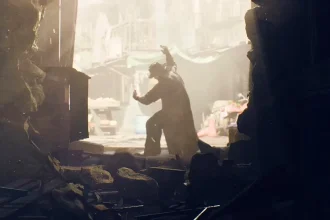The Assassins return - this time to the dark and dangerous Sengoku era. "Assassin's Creed: Shadows" promises to take the franchise to a new level. We dived into the shadows to find out whether the latest offshoot delivers what it promises. Is this the in-depth Assassin's Creed-Is this the title that fans have been waiting for or a step too far into the dark? Find out in our preview review.
Two warriors, two fates
"Assassin's Creed Shadows" introduces us to two protagonists: Yasuke and Naoe - an unlikely duo who must assert themselves in the midst of betrayal, war and political machinations. The franchise thus returns to a concept that was already very popular with players in "Assassin's Creed Syndicate".
Yasuke is an imposing warrior with a fascinating past. Originally an African slave, he fights as a samurai alongside Oda Nobunaga - a powerful daimyō and brutal general. But he wears more than just armor - his secret mission could change the fate of entire nations. Marked by inner turmoil and driven by justice, he asks himself the all-important question: how much humanity can he sacrifice for his mission?

Naoe, the brilliant strategist, operates from the shadows. She is a master of tactics, but her past repeatedly draws her into a web of intrigue and betrayal. Despite her keen intelligence, she bears deep emotional scars - and trusts few. At the center of the story is the murder of her father, which she wants to avenge - a hunt that ultimately brings her and Yasuke together. But when they unmask the masterminds, a larger political agenda is revealed that brings them both into a conflict of conscience.
"Assassin's Creed: Shadows" delivers a gripping story full of intrigue, honor and moral conflict. The fascinating characters drive a narrative that not only convinces with impressive action, but also with emotional depth. If you like epic samurai dramas with a historical background and can overlook the fact that this is an entertainment product and not a history book, then you are in good hands here.
A shared history, two styles of play
Right from the start, the game makes the differences between the two clear: he, the man for the rough stuff, she, the silent blade. This dual hero principle also characterizes the gameplay. Yasuke relies on brute strength and direct confrontation, while Naoe acts with cunning and guile. Two characters, two completely different ways of playing - and yet one common goal.
Yasuke charges through hordes of enemies with his massive katana, slaughtering ronins and leaving nothing but devastation in his wake. In brutal, fast-paced battles, he strikes down opponents and conveys a pervasive sense of superiority. His melee skills are almost unmatched, sometimes ponderous, and even his counterattack and stealth gameplay has its own flavor: with sheer power and speed, he can overwhelm guards before they can even react.
In stark contrast to this is Naoe, who redefines the concept of assassin art. Instead of brute force, she relies on strategy, stealth and deceptive maneuvers based on classic shinobi moves. Her specialty: moving almost invisibly through enemy territory, outwitting guards and carrying out silent attacks without raising the alarm. Their weapons - including a set of sharp handguns, katanas or a kusarigama - allow for targeted, precise hits. But their real strength lies in manipulating the environment: setting traps, distracting opponents and evading entire patrols through clever deception.

Gameplay with Naoe requires patience and caution. Her ability to gather information and psychologically trick enemies makes her a silent threat. Her special maneuvers range from paralysis attacks to silent eliminations. For those who embrace stealth and forward planning, Naoe is one of the most exciting characters in the game.
The special moves are a particular highlight: the screen is bathed in monochrome colors, only the blood glows intensely, while you strike down several enemies at once with a powerful counterattack. These attacks allow you to literally plow through the enemy ranks and combine them with other attacks - a wonderful feeling of superiority that makes light work of the game. Mortal Kombat-vibes.
What is somewhat surprising is how meticulously the game teaches various fighting techniques and the use of weapons, although in the end it is often the sheer strength of a character that decides victory or defeat. Nevertheless Assassin's Creed Shadows numerous opportunities to get to grips with the weapons - an essential aspect of Japanese martial arts. This tactical depth is particularly evident at higher difficulty levels, where the choice of weapon can really make all the difference. It would certainly be nice if this had been pushed more, but it's up to you to deal with it.

Different playing styles, same intensity
The differences between Yasuke and Naoe go far beyond gameplay - they affect the entire gaming experience. But both styles are masterfully realized, and the battle system is one of the best in the series in my opinion. Melee combat is more intense and powerful than ever, and even stealth mechanics can lead to merciless executions. The spikes of violence go as far as decapitation - a real feast for fans of uncompromising action and a satisfying feeling at the end of it all.
The alternation between Yasuke and Naoe again makes for a refreshing approach. In many missions, you can freely choose who is better suited to the situation at hand. However, there are also passages that absolutely require a specific character - sometimes not until the final boss fight. This can be frustrating when you realize that you have made the wrong choice and have to start a quest from scratch. This is also reflected in the difficulty level, because although I played in a more story-oriented way, the difficulty level increases rapidly from objective to objective and you have to spend a lot of time on side missions and quests to have any chance at all.
Is this still Assassin's Creed?
And then the big question arises: is this still an Assassin's Creed at all? Sure, iconic elements such as the hidden blade, the death jump and countless references are there. The structure is more reminiscent of an open-world RPG à la "Ghost of Tsushima" than a real assassin's adventure. The most striking thing is that the original Assassin story with the Templars is almost non-existent and there are also no sequences in the present day, although this had long been established by this point. On the other hand, this could also be seen as an aspect with which the game stands on its own.
Although there is also a linear main story, new storylines unfold along the way. You eliminate corrupt Daikan in Omi, help build up a tea trade elsewhere and invest in your own strength to be able to take on ever more powerful enemies. It is a complete alternative to the rather compact "Assassin's Creed Mirage". If you get involved, you will get a huge, detailed world full of stories - but if you are expecting a classic "Assassin's Creed", you might be a little surprised.
An open-world masterpiece with historical depth
"Assassin's Creed Shadows" also sets new standards in open-world design and raises the genre to an impressive level. Ubisoft unleashes a visual splendor that not only pushes technical boundaries, but also feudal Japan with breathtaking attention to detail brought to life. Here, the world is not just a backdrop - it breathes, narrates and feels authentic. Above all, the meticulously reconstructed natural scenery is not only visually impressive, but also conveys the feeling of really walking through the Sengoku period. Nine sprawling provinces showcase Japan's full diversity: rugged volcanic landscapes, dense forests, peaceful rice paddies - each region has its own character and tells its own story.
The dynamic seasonal system, which constantly changes the game world, is particularly impressive. In spring, cherry blossoms enchant the landscape with a touch of poetry, while in summer the fields glow in lush green. Autumn bathes the world in a spectacular play of red and gold, before winter brings an almost meditative silence with its snow-covered plains. However, these changes appear to be merely cosmetic - they do not affect the gameplay or present the player with the challenge of adapting their tactics accordingly.

Architecturally, Ubisoft has also spared no effort: shrines, temples and villages have been reconstructed with meticulous precision and in collaboration with historians. Each building reflects the architectural traditions of the 16th century, which not only makes the game world impressive, but also gives it a tangible depth. This includes the countless mini shrines along the roadsides, which repeatedly invite you to pause and pray - a moment of reflection and renewal. All of this impressively reflects the Japanese tradition that has been preserved for centuries.
But not everything is perfect: anyone hoping for the parkour-heavy city design of "Assassin's Creed Mirage", for example, is likely to experience disillusionment here. There are hardly any dense metropolises; instead, wide landscapes interspersed with small villages dominate. Although locations such as Azuchi Castle offer vertical exploration opportunities, the impression often remains that Ubisoft places more value on picturesque postcard motifs than on the truly varied movement that the series stands for. And yes, the classic problems with climbing still persist slightly and lead to unintentional actions in hectic moments.

And despite the numerous discoveries, the distances covered can sometimes be time-consuming - even on horseback. Added to this is the laborious search for people whose locations are only vaguely described on the huge map. Scouts can help, but their assistance is limited. The search is like looking for a needle in a haystack.
Hidden places and the freedom to explore
However, exploring the world plays just as central a role as the main story. Remote temples, secret caves and hidden villages invite you to discover them. One of my highlights was the bamboo ghost forest, which creates a truly eerie atmosphere. This so-called hideouts not only offer challenges and collectibles, but also the opportunity to delve deeper into the culture of Japan. The individual design of your own hideout provides a personal touch and gives the game an additional level of depth. It is a place of preparation, reflection and tranquillity - and therefore a central element that makes "Assassin's Creed Shadows" special.
The attention to detail should also be emphasized: from traditional Japanese craftsmanship to realistic materials such as ceramic tiles or wood preservation methods - the architecture feels tangible. The natural surroundings are in no way inferior: Textures of trees, rocks and bodies of water have been meticulously crafted, giving the world an impressive depth. The result? One of the most beautiful games of this generation, which can even keep up with graphical heavyweights such as "Black Myth: Wukong" - with excellent performance on the PS5 Pro.

A soundtrack that brings the shadows to life
The music in "Assassin's Creed Shadows" is the final piece of the puzzle and is far more than just an atmospheric backdrop - it takes the game to a new emotional level. With epic yet subtle melodies, the music takes the game to a new emotional level.The soundtrack blends seamlessly into the dark world and enhances every mood. Every step into the shadows is accompanied by a tonal depth that perfectly balances tension and tranquillity.
The musical variety is particularly impressive: from rousing orchestral scores that intensify the action to gentle, minimalist sounds that invite you to linger. Rock sounds also provide powerful accents in cinematic sequences. Traditional instruments lend the music an authentic, historical character, while modern sounds emphasize the futuristic aspects of the game. The soundtrack not only creates a deeper connection to the story, but also makes the emotions of the characters tangible. In "Assassin's Creed Shadows", the music is not just an accessory, but an essential part of the experience - so intense that the boundaries between the game world and reality become blurred. And in the best 3D sound.
Co-Writer: Niklas
Conclusion

